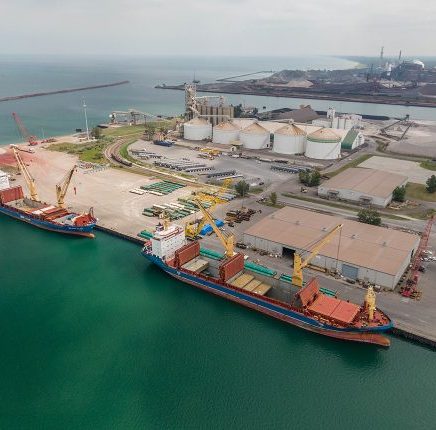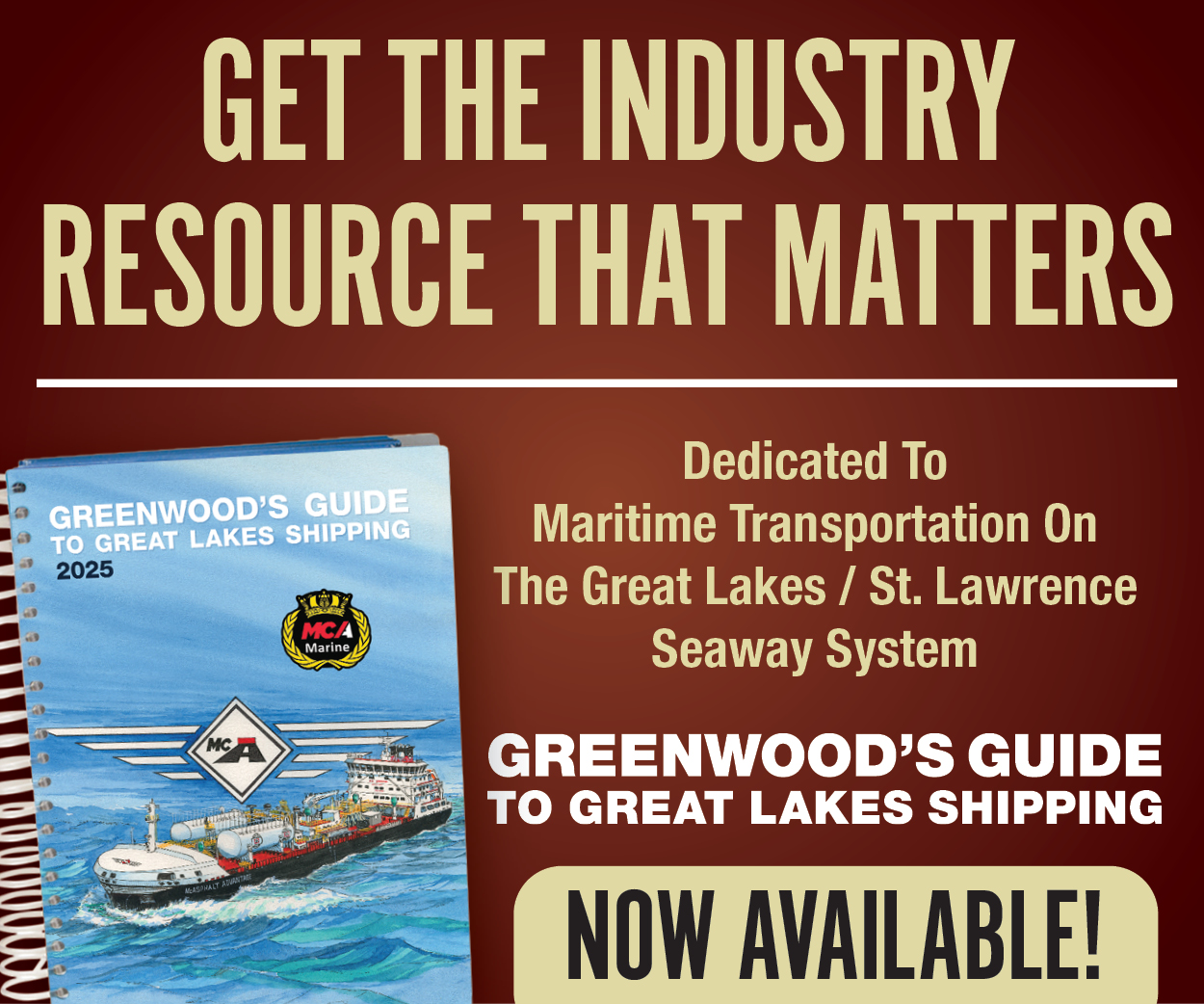State of Ohio Benefits from Port of Cleveland’s Maritime Initiatives
This economic analysis is presented within a recent report prepared for the Ohio Department of Transportation (ODOT): “Ohio Maritime Plan Working Paper 4: Economic Impacts of the Ohio Maritime System.” It’s the latest in a series of reports by Martin Associates, along with the consultancy CPCS, that have tracked and analyzed, since 2019, maritime impacts in Ohio, for Lake Erie ports and three Ohio River port areas.
For Lake Erie plus Ohio River activities, Martin Associates estimates a statewide impact of $40 billion. The Ohio River inland waterway portion is estimated at $23.2 billion.
In Cleveland, the figure for 2023 is $2.37 billion higher than for 2021, which was $4.7 billion. Cleveland authorities write that the surge in economic impact can be attributed to increased iron ore tonnages (up to nearly 9 million metric tons in 2023), higher output (cargo throughput, vessel traffic, etc.) and improved salaries and income multipliers.
In December, the Port of Cleveland highlighted the report and its statistics.

“Cleveland’s harbor and river system is not just a local maritime and recreational asset. It’s a major economic powerhouse. As the public guardian of the maritime sector, the Port of Cleveland continues to prove itself as an economic engine for Cuyahoga County and northeast Ohio,” said Will Friedman, former president and CEO of Port of Cleveland. “These numbers demonstrate we are headed in the right direction.”
Friedman also touched on his departure from port leadership. “I am especially gratified to see this report as I conclude my tenure,” he said. “The port’s economic development work and tools are more relevant than ever. Our unique combination of shipping services, infrastructure investment and financing capabilities has proven to be a potent combination for driving growth and job opportunity across the region.”
Future Plans
Friedman had served as CEO of Port of Cleveland since 2010. His contract ended in December because he and the port board did not reach agreement on a new contract. Under Friedman’s 14-year leadership, the port expanded its impact on regional economic development, environmental stewardship and infrastructure investment.
In November, Dave Gutheil, the port’s current chief commercial officer, was named interim CEO. Gutheil is focusing on some of the port’s infrastructure projects scheduled for this year, including the Irishtown Bend stabilization project on the Cuyahoga River; the electrification of the largest warehouse at the port’s General Cargo Terminal and the modernization of the ore tunnel at Cleveland Bulk Terminal. “Each of these projects,” Gutheil wrote in an email, “is vital to the movement of cargo in northeast Ohio.”

Another focus is on expanding container operations and to identify project cargo movements destined for major infrastructure projects in the Midwest. Also under study are new developments in agricultural shipping via new container services, possibly starting within the next 12 months.
Last fall the port received $94 million from the U.S. EPA’s Clean Ports Program. Gutheil said the funding agreement between the port and the EPA is finalized, and projects are in the planning phase.
Gutheil said the biggest takeaway from the ODOT report “is the overall importance of the maritime sector to the Ohio economy. It is vital to the movement of goods, in and out of Ohio, both on Lake Erie and the Ohio River.” The port will use the report to inform both the public and state legislators that “investment in maritime infrastructure at ports pays large dividends to local, regional and statewide economies.”
The report from Martin Associates is drawn from cargo data, both for raw material and manufactured products, direct and indirect income as well as tax revenue generated for Ohio and its municipalities. Total numbers reflect the aggregate sum of this activity.
Martin Associates emphasizes that only measurable impacts are included in the study. The primary data was developed through 184 interviews and telephone surveys with port tenants and firms working within Ohio’s maritime transportation system, including port authority officials, marine terminal operators, barge lines, fleeting operators, maritime service providers and port tenants. The firm developed Ohio-specific re-spending models in order to reflect unique economic and consumer profiles in Ohio. Martin Associates states that standardized impact models were not used, adding that “the resulting impacts reflect the uniqueness of the state’s port and maritime operations, as well as the surrounding regional economies.”
Martin Associates points out that Ohio’s maritime transportation system is unique because it includes three separate modes of waterborne commerce for shipment and receipt of raw materials and finished products.
- International ships moving cargo through the St. Lawrence Seaway (“salties”)
- Lake vessels carrying international cross-lake and domestic intra-lake shipments (“lakers”)
- Barges moving international and domestic cargoes on the Ohio River
The report states that the “convergence of water transportation modes provides steel mills and other industries with the ability to use cost-effective methods for receiving raw material products to domestic and international markets. Without water transportation, production costs would undoubtedly increase and therefore potentially hinder future contracts and levels of manufacturing.”
This economic activity is reflective of related employment impacts. The report finds that waterborne shipping in Ohio supported 130,798 jobs in 2023. That total number includes 17,439 jobs directly created by cargo shipping and dependent industrial activities. These employees were paid $1.1 billion in wages and salaries. Their purchasing power contributed to almost $2.4 billion in downstream benefits.
- 16,374 “induced jobs” resulting from the direct employees’ expenditures
- 21,133 “indirect jobs” resulting from all local spending
- 75,852 “related jobs” associated with the processing and movement of steel products, fertilizer, grain and dry bulk cargoes the individual terminals
This economic activity benefits public coffers, with Martin Associates estimating that direct and indirect maritime expenditures generated a total of $970.3 million in tax revenues. About 55.5 percent ($539 million) went to the state of Ohio. The $431.3 million balance went to local jurisdictions.
Utilizing the Report
Randy Lane, statewide planning manager at ODOT, said the report will be useful to the state as it prepares for future project development and looks for ways to improve economic development. “The working paper supports and informs our Ohio Maritime Plan, which is scheduled for completion in April 2025,” he added.
Lane explained that the December report will help support and inform the overall plan, particularly the development of port profiles for the Lake Erie ports as well as the port statistical areas on the Ohio River. A port statistical area refers to a geographically defined region encompassing a group of ports. The term is used by the U.S. Army Corps of Engineers to collect and analyze data on waterborne commerce within that area. The Cincinnati/Northern Kentucky river ports, for example, comprise one statistical area.
Lane added that the port profiles will include data that can be shared with economic development teams, regional planning agencies, private businesses and others to describe and promote the capabilities and capacities of the Ohio maritime system.
More specifically, the profile information will include the following information.
- Port district biography
- Top commodity types and volumes, including a commodity flow map and graphic showing inbound/outbound, origin and destination
- Economic impact
- Terminals and dock locations
- Multimodal connections
- Key assets such as dock space and equipment
- Capital needs
Lane said the data will be used to demonstrate economic impact, both in Ohio and beyond. Plus, ODOT will use the data to educate citizens and decision-makers and to make clear which commodities contribute to a port’s successes, as well as understanding trends. Critically, Lane added that “the data will be used to evaluate intermodal projects proposed for the Ohio Maritime Assistance Program that is administered by ODOT.”

HOPA Ports Seeks to Build New Port at Sault Ste. Marie
In September, the Hamilton Oshawa Port Authority (HOPA) and the city of Sault Ste. Marie, Ontario, announced a partnership to develop a multimodal port and trade corridor connecting northern Ontario... Read More

Ports of Indiana Receives FEMA Grants for Security
Ports of Indiana has been awarded two federal grants from the Federal Emergency Management Agency (FEMA) to strengthen security infrastructure and assessment capabilities at its Burns Harbor and Jeffersonville ports. The FEMA Port... Read More


